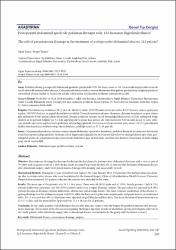| dc.contributor.author | Erşen, Ogün | |
| dc.contributor.author | Yılmaz, Sezgin | |
| dc.date.accessioned | 2022-06-30T08:16:05Z | |
| dc.date.available | 2022-06-30T08:16:05Z | |
| dc.date.issued | 2020 | en_US |
| dc.identifier.citation | Erşen, O., & Yılmaz, S. (2020). Postoperatif abdominal apselerde perkütan drenajın rolü; 111 hastanın değerlendirilmesi. Genel Tip Dergisi, 30(4). | en_US |
| dc.identifier.issn | 2602-3741 | |
| dc.identifier.uri | https://hdl.handle.net/20.500.12933/1272 | |
| dc.description.abstract | Amaç: Perkütan drenaj, postoperatif abdominal apselerde günümüzde %70-100 başarı oranı ve %1-10 arasında değişen nüks oranı ile
tercih edilen ilk yöntem halini almıştır. Çalışmamızda batın cerrahisi sonrası abdominal abse gelişen, görüntüleme eşliğinde perkütan
yöntemlerle drenaj yapılan ve başarılı bir şekilde tedavi edilen 111 hastanın verilerini sunmayı amaçladık.
Gereç ve Yöntem: Ocak 2013 ve Ocak 2018 arasındaki 5 yıllık süre boyunca, Afyonkarahisar Sağlık Bilimleri Üniversitesi Hastanesinin
Genel Cerrahi Kliniğinde yatan, postoperatif apse nedeniyle perkütan drenaj yapılan 137 hasta dosyası incelendi. Kriterlere uygun
111 hasta çalışmaya dahil edildi.
Bulgular: Hastaların yaş ortalaması 58.1±16.6 idi. 68(%61) erkek, 43(%39) kadın hasta mevcuttu. 8(%7) hastaya sadece aspirasyon
yapıldı, 103(%93) hastaya ise pigtail drenaj kateteri takıldı. Drenaj kateterinin çıkması, tıkanması, drenajın bozulması ve apse tekrarı
gibi nedenlerle 9(%8) hastaya işlem tekrarlandı. Drenaj gerektiren apsenin en sık bulunduğu lokalizasyon %25 ile subhepatik bölge
olurken en az görülen bölgeler ise %1.8 ile suprahepatik ve psoas kası çevresi idi. Tüm hastaların %40’ını safra kesesi ve safra yollarına yönelik operasyon yapılan hasta grubunun oluşturduğu görüldü. Hastaların ortalama serviste yatış süresi 15±17.5 gün olmakla
birlikte tüm hastaların ortalama takip süresi(drenlerin çekildiği tarih) ise 17.5±18 gün idi.
Sonuç: Çalışmamızda pankreas cerrahisi sonrası oluşan abdominal apsesi olan hastaların, perkütan drenaj ile en uzun süre hastanede
yatan hasta grubu olduğu görüldü. Yerleşim olarak değerlendirildiğinde ise, en uzun yataklı tedavi ve takip gerektiren apse alanı gastrohepatik aralık idi. Çalışmamızda ilgi çekici olarak abdominal apse nedeni mide cerrahisi olan hastalar iyileşmenin en hızlı olduğu
grup olarak tespit edildi. | en_US |
| dc.description.abstract | Objective: Percutaneous drainage has become the first method of choice for postoperative abdominal abscesses with a success rate of
70-100% and recurrence rates of 1-10%. In this study, we aimed to present the data of 111 patients who developed abdominal abscess
after abdominal surgery, underwent percutaneous drainage with imaging and successfully treated.
Material and Methods: During the 5-year period between January 2013 and January 2018, 137 patients who had percutaneous drainage due to postoperative abscess who were hospitalized in the General Surgery Clinic of Afyonkarahisar Health Sciences University
Hospital were examined. 111 patients who met the criteria were included in the study.
Results: The mean age of the patients was 58.1 ± 16.6 years. There were 68 (61%) male and 43 (39%) female patients. Only 8 (7%)
patients underwent aspiration, and 103 (93%) patients underwent a pigtail drainage catheter. The procedure was repeated in 9 (8%)
patients because of drainage catheter dislocation, obstruction and drainage failure. The most common localization of the abscess requiring drainage was the subhepatic region with 25%, while the least seen regions were suprahepatic and psoas muscle circumference
with 1.8%. It was seen that 40% of all patients were operated for gall bladder and bile ducts. The mean duration of hospitalization was
15 ± 17.5 days, and the mean follow-up period was 17.5 ± 18 days for all patients.
Conclusion: In our study, patients with abdominal abscess after pancreas surgery were the longest hospitalized patients with percutaneous drainage. The location of the abscess area requiring the longest inpatient treatment and follow-up was gastrohepatic interval. In
our study, patients with abdominal surgery due to abdominal abscess were found to be the group with the fastest recovery. | en_US |
| dc.language.iso | tur | en_US |
| dc.publisher | Selçuk Üniversitesi | en_US |
| dc.rights | info:eu-repo/semantics/openAccess | en_US |
| dc.subject | Abdominal apse | en_US |
| dc.subject | Perkütan drenaj | en_US |
| dc.subject | Cerrahi | en_US |
| dc.subject | Abdominal abscess | en_US |
| dc.subject | Percutanous drainage | en_US |
| dc.subject | Surgery | en_US |
| dc.title | Postoperatif abdominal apselerde perkütan drenajın rolü; 111 hastanın değerlendirilmesi | en_US |
| dc.title.alternative | The role of percutaneous drainage in the treatment of postoperative abdominal abscess; 111 patient | en_US |
| dc.type | article | en_US |
| dc.authorid | 0000-0002-3626-0264 | en_US |
| dc.department | AFSÜ, Tıp Fakültesi, Cerrahi Tıp Bilimleri Bölümü, Genel Cerrahi Ana Bilim Dalı | en_US |
| dc.contributor.institutionauthor | Yılmaz, Sezgin | |
| dc.identifier.volume | 30 | en_US |
| dc.identifier.issue | 4 | en_US |
| dc.identifier.startpage | 242 | en_US |
| dc.identifier.endpage | 247 | en_US |
| dc.relation.journal | Genel Tıp Dergisi | en_US |
| dc.relation.publicationcategory | Makale - Ulusal Hakemli Dergi - Kurum Öğretim Elemanı | en_US |
















